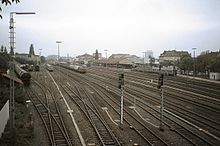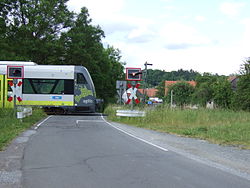Weiden – Bayreuth railway line
| Weiden-Bayreuth | |||||||||||||||||||||||||||||||||||||||||||||||||||||||||||||||||||||||||||||||||||||||||||||||||||||||||||||||||||||||||||||||||||||
|---|---|---|---|---|---|---|---|---|---|---|---|---|---|---|---|---|---|---|---|---|---|---|---|---|---|---|---|---|---|---|---|---|---|---|---|---|---|---|---|---|---|---|---|---|---|---|---|---|---|---|---|---|---|---|---|---|---|---|---|---|---|---|---|---|---|---|---|---|---|---|---|---|---|---|---|---|---|---|---|---|---|---|---|---|---|---|---|---|---|---|---|---|---|---|---|---|---|---|---|---|---|---|---|---|---|---|---|---|---|---|---|---|---|---|---|---|---|---|---|---|---|---|---|---|---|---|---|---|---|---|---|---|---|
|
Railcars at the Wunaustraße level crossing in Bayreuth
| |||||||||||||||||||||||||||||||||||||||||||||||||||||||||||||||||||||||||||||||||||||||||||||||||||||||||||||||||||||||||||||||||||||
| Route number : | 5051 | ||||||||||||||||||||||||||||||||||||||||||||||||||||||||||||||||||||||||||||||||||||||||||||||||||||||||||||||||||||||||||||||||||||
| Course book section (DB) : | 867 | ||||||||||||||||||||||||||||||||||||||||||||||||||||||||||||||||||||||||||||||||||||||||||||||||||||||||||||||||||||||||||||||||||||
| Route length: | 58.1 km | ||||||||||||||||||||||||||||||||||||||||||||||||||||||||||||||||||||||||||||||||||||||||||||||||||||||||||||||||||||||||||||||||||||
| Gauge : | 1435 mm ( standard gauge ) | ||||||||||||||||||||||||||||||||||||||||||||||||||||||||||||||||||||||||||||||||||||||||||||||||||||||||||||||||||||||||||||||||||||
| Top speed: | 120 km / h | ||||||||||||||||||||||||||||||||||||||||||||||||||||||||||||||||||||||||||||||||||||||||||||||||||||||||||||||||||||||||||||||||||||
|
|||||||||||||||||||||||||||||||||||||||||||||||||||||||||||||||||||||||||||||||||||||||||||||||||||||||||||||||||||||||||||||||||||||
The Weiden – Bayreuth line is a main line in Bavaria . It connects Weiden in the Upper Palatinate via Kirchenlaibach with Bayreuth .
history
The concession to build the Irrenlohe (near Schwandorf ) –Weiden-Bayreuth line was awarded to the Actiengesellschaft der Bavarian Eastern Railways on January 3, 1862. Construction work began that same year, and the line was officially opened on December 1, 1863. From Schwandorf station to Irrenlohe station, it ran on a single track parallel to the Regensburg –Schwandorf– Amberg – Nuremberg railway line, which was also single-tracked . In Bayreuth it ended in its own train station south of the then “Brandenburger Tor”, which received a locomotive shed , a goods hall , a wagon depot and a block of flats for service apartments. For cost reasons, however, passenger traffic was handled right from the start on the platform immediately north of it on the "leased railway" to Neuenmarkt-Wirsberg , which had existed since 1853 .
When the eastern railway line went into operation, the former Bayreuth terminus became a through station on the Hof – Bayreuth – Weiden – Regensburg – Munich route , with transfers being made in Bayreuth and Irrenlohe. From now on, the route from Bayreuth to Munich was 40 miles, 12.5 miles shorter than the one via Augsburg . Train crossings were planned in Parkstein -Hütten, Kemnath - Neustadt , Kirchenlaibach and Seybothenreuth .
Initially, three pairs of passenger trains ran between Bayreuth and Irrenlohe. As early as the 1860s, a passenger train (“Courierzug” with exclusively high- class wagons ) was added to international traffic without changing wagons between Cologne and Vienna.
On January 1, 1876, the Ostbahngesellschaft was nationalized and the route was taken over by the Bavarian State Railways . By changing the road layout in the same year, the two Bayreuth train stations could be merged.
The Schwandorf – Weiden section is now assigned to the Regensburg – Weiden railway line .
Route description
course
The route leaves Weiden train station in a north-westerly direction and initially runs along the B 470 past the Weiden districts of Rehbühl and Weiden-West and the Seltmann porcelain factory . At the level of the Brandweiher settlement, the route first swings to the south-west, then runs in a north-westerly direction through the Manteler forest and from Schwarzenbach along the Haidenaab to Pressath . There the branch line to Kirchenthumbach branched off until 1962 , today only the siding to the Grafenwöhr military training area . Next, the route runs along the Haidenaab, bypasses the Rough Kulm on the eastern side and hits the station Kirchenlaibach to the Nuremberg-Cheb railway . Behind Kirchenlaibach the route runs north-west along the B 22 through the Seybothenreuther Forest and between the Pensen and the Schlehenberg to Bayreuth. It leads past the Bayreuth districts of Grunau, Colmdorf and Neue Heimat and then meets the railway line from Schnabelwaid . The two lines cross the river valley of the Red Main in parallel on an almost 1.5 km long dam, the line from Weiden runs on the eastern of the two tracks. Coming from the south, the two routes first cross the B 22 (Wieland-Wagner-Straße), then the Bayreuth Mühlkanal and finally, just before the entrance to Bayreuth Central Station , first the B 2 (Albrecht-Dürer-Straße) and directly afterwards the Red Main.
Weiden station with the outgoing train to Bayreuth, to the right the line to Oberkotzau
Ostkopf of the Kirchenlaibach train station : In the foreground an operating track , in the middle the exit towards Weiden, on the left a VT 612 to Marktredwitz
West station head in Kirchenlaibach: To the left the double-track line to Schnabelwaid , right single-track to Bayreuth
Colmdorf railway bridge
Railcar of the type Stadler Regio-Shuttle RS1 in front of the Bayreuth district of Neue Heimat
State of development
The track structure and the engineering structures had been dimensioned from the beginning for the later installation of a second track. This measure was not implemented, the entire length of the line is single-track and not electrified.
Stations

- Bayreuth Hbf: see Bayreuth Hauptbahnhof .
- Hermitage: The station near the Hermitage Park was opened as a stop on December 1, 1910. It received a single-storey reception building in wood construction. In 1939 a crossing track and a small signal box were built, both of which were dismantled in 1971. In 1973 the station was given up, the building no longer exists.
- Kemnath-Neustadt: The train station is roughly halfway between Kemnath and Neustadt am Kulm , about five kilometers from Kemnath city center. It has a crossing track, the loading track has been dismantled. The goods hall still exists, the two-storey reception building has been replaced by a flat new building made of clinker brick.
- Kirchenlaibach: see Kirchenlaibach train station .
- Seybothenreuth: The train station with its brick, two-story entrance building is already listed in the first timetable. The crossing and loading track were removed in 1977 and the station downgraded to a stop.
- Stockau: The station appears for the first time in the timetable from 1876, the station building on the periphery dates from 1883. It has a crossing track, the loading track has since been removed. The original platforms are no longer used, closer to the town center two side platforms were built.
- Weiden: see train station Weiden (Oberpf)
Kirchenlaibach train station railcar series RS1 of the company Agilis
Pressath station
Weiden station with Agilis railcars from Bayreuth on track 3, on the left a garbage train from Schwandorf
Trains
Diesel multiple units of the type Stadler Regio-Shuttle RS1 from agilis operate on the route . In addition, there is regular freight traffic with garbage trains to the Schwandorf waste incineration plant , occasionally trains with prefabricated garages and military trains to the Grafenwöhr military training area.
Web links
literature
- Manfred Bräunlein: The Eastern Railways . Lorenz Spindler, Nuremberg 2000, ISBN 3-88929-078-7 .
- Robert Zintl: Bayreuth and the railroad . 1st edition. Gondrom, Bindlach 1992, ISBN 3-8112-0780-6 .
Individual evidence
- ↑ Manfred Bräunlein: The Eastern Railways . Lorenz Spindler, Nuremberg 2000, ISBN 3-88929-078-7 , p. 74 .
- ^ Robert Zintl: Bayreuth and the railway . Gondrom, Bindlach 1992, ISBN 3-8112-0780-6 , p. 43 .
- ↑ Manfred Bräunlein: Die Ostbahnen , p. 156.
- ↑ a b Manfred Bräunlein: Die Ostbahnen , p. 148.
- ^ Robert Zintl: Bayreuth and the Railway , p. 47.
- ↑ Manfred Bräunlein: Die Ostbahnen , p. 149.
- ^ Robert Zintl: Bayreuth and the Railway , p. 42.












